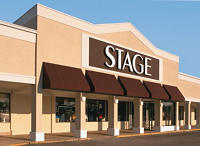The most important number for Stage Stores (SSI) is one that is key across the entire retail industry: comparable sales.
Comparable sales, or same-store sales, reflect the change in sales at established stores, generally locations that have been open for at least a year. For most retailers, sales from established locations make up the majority of overall revenue, and are key in determining a company's bottom-line performance.
Comparable sales at Stage Stores fell 2% last year, its worst performance in the last five years, and dropped 3.4% in the fourth quarter during the key holiday selling season. Over the last five years, comparable sales have been erratic, but mostly positive.
| Year | 2015 | 2014 | 2013 | 2012 | 2011 |
| Comparable Sales Growth | -2% | 1.4% | -1.5% | 5.7% | 0.5% |
Source: 10-K filings
Stage Stores shares have fallen nearly two thirds in the last year as the same-store sales growth of 2014 reversed to last year's drop. The stock plummeted following the company's second-quarter earnings report as it badly missed earnings estimates and its own forecast, and that pattern repeated itself in subsequent quarters as falling oil prices and a weak peso pressured sales at Stage's stores in oil-rich southern regions and near the Mexican border.
The importance of same-store sales
Beyond the straightforward importance of same-store sales, the metric carries an outsize weight on the bottom-line of retailers for two major reasons.
First, retailers tend to have high operational leverage, meaning many of their expenses are fixed, tied up in SG&A expenses, occupancy costs, and even labor, so profits grow disproportionately as sales increase. Clothing tends to be marked up 100-350%, and furniture even more so. Therefore, the majority of incremental same-store sales growth goes to the bottom line once those fixed expenses are satisfied.
The other major reason is that merchandise purchases are tied to sales expectations. Retailers stock inventory and make orders according to sales projections, and when sales underperform, the businesses are forced to mark merchandise down substantially, cutting into profits and sometimes even selling at a loss. In Stage Stores' most recent earnings report, CEO Michael Glazer said that in light of soft traffic, "we responded with higher than planned markdowns that enabled us to reduce inventory levels; ending the year (with inventory) more than 1% below last year." The decrease in inventory was slightly less than the full-year decline in sales at 2.1%, indicating the company managed the slowdown well.
Looking ahead
For 2016, management projected a comparable sales decline between -3% and -1%, and an overall sales decline of about 2.5% to 4.6% as it plans to close 30 stores. Based on that projection, the company expects a full-year profit of $0.40-$0.60 per share, in line with the $0.51 EPS it made last year. CEO Glazer promised to "continue to operate with disciplined expense controls and inventory management as we remain cautious in the current environment."
Image Source: Stage Stores
Management will have to cut expenses to maintain the same level of profitability from a smaller revenue base. However, the company's same-store sales growth this year should be the clearest indicator of whether the company can deliver on its same-store sales forecast, or even exceed it. The company has set a low bar for itself, already projecting a decline in comps. More than three months into the year, there is at least one sign favoring Stage's recover: oil prices have rebounded to a new 2016 high above $43. If management is correct that the oil crash was a significant weight on sales, this should be good news for Stage investors.





